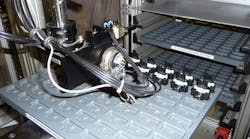Now Is the Time for Manufacturing to Digitize Standard Operating Procedures
During the COVID-19 pandemic and maybe for the long term, we need to rethink how we currently operate. What do we need to streamline? What are we doing now that may become a permanent part of our new reality? Which employees are qualified or trained to perform a specific task?
This new landscape means our business processes need to reflect our standards procedures and vice versa.
Social distancing and new efficiency measures may mean that employees come to work in isolated shifts to perform specific jobs. They may leave before or just as the next isolated shift comes in. SOPs are crucial to onboarding and training new employees and for those tasked with taking on new or different jobs.
Standard operating procedures formalize manufacturing processes, coordinate team members, help maintain productivity and reduce risks. They provide detailed instructions and are essential to the way we need to do business these days.
You can implement standard operating procedures and operating checklists to ensure that your manufacturing operations are consistent across your company.
Done right, SOPs avoid manufacturing process shut-downs caused by equipment failure, missed preventive maintenance schedules and work orders, and new employees. In manufacturing, standard operating procedures are crucial. The best SOPs achieve efficiency on the line, products that meet quality controls, and state and federal regulatory compliance measures.
Standard operating procedures are also solid proof of quality assurance plans in action across manufacturing sites or lines.
Definition: Standard Operating Procedures (SOP)
In manufacturing, SOPs are step-by-step written instructions that define how to perform repetitive tasks to achieve desired outcomes.
Isin Akyar defines a standard operating procedure as “a process document that describes in detail the way that an operator should perform a given operation.” You can easily use a standard operating procedure template to create uniform expectations and easy-to-read instructions.
SOPs detail how to perform and complete a task. They are often in the form of a repeating work order, a preventative maintenance work order, or an inspection.
Maybe a new centrifuge replaces the old rusty one and the preventive maintenance work order is completely different. An online standard operating procedure will clearly define the process. Automated SOPs should include figures, photographs, and maybe even a link to the new equipment’s maintenance manual.
Manufacturing facility and product inspectors frequently ask to review standard operating procedures when auditing operations. And, in the case of legal action, SOPs can serve as crucial defense documentation of procedures followed within industry guidelines.
6 Benefits of Manufacturing Standard Operating Procedures
Here are 6 of the leading benefits of implementing SOPs in a manufacturing facility:
- Standardization
- Communication
- Efficiency
- Regulatory Compliance and Quality Assurance
- Accountability and Tracking
- DOWNTIME
Standardization
The very purpose of a standard operating procedure is to establish a standard and consistent way of completing a task. Assigning approved SOPs means that the task should be always performed the same way across manufacturing facilities and production lines.
Manufacturing SOPs streamline processes, improve consistency, and allow management to make informed business decisions based on how well a standard works.
Communication
Once standardized, data can now be easily shared with other people, improving work and communication between all levels of the team. This will also reduce your risk of non-compliance and improve supply chain efficiencies.
Manufacturing SOPs communicate across all facility and team levels. When digitized, standardized manufacturing SOPs provide real-time important information. Operation managers can check on work being done, how it is being done, and if something is getting in the way.
SOPs can even standardize how a team communicates. Streamlining internal communications creates efficiencies across the company.
Efficiency
Managers are always looking to improve production efficiency with their teams. SOPs make your workforce efficient, predictable, and measurable.
From how a new piece of equipment runs to how a manager audits performance, repeatable processes can always be made more efficient with an SOP. Perhaps a few steps are redundant and don’t present any additional value. Or, you may discover a frequent error or mistake that can be prevented by adding a step to the SOP.
Regulatory Compliance and Quality Assurance
Manufacturers can demonstrate regulatory compliance through manufacturing SOPs that promote worker safety and quality assurance.
OSHA’s General Duty Clause enforces worker health and safety. OSHA inspectors look for anything that can cause danger or bodily harm to an employee, on or off the job. Step-by-step SOPs are crucial for reinforcing safety and compliance standards.
Online, easy-to-follow standard operating procedures improve a company’s credibility and legal defenses. In fact, during auditing procedures, inspectors frequently rely on completed SOPs as checklists.
Running quality systems is also an important part of a manufacturing company. The International Organization for Standardization (ISO) developed ISO 9000 to define a “quality management system.” Companies need to aim to:
- Consistently provide products and services that meet customer and legal and regulatory requirements, and
- Enhance customer satisfaction through the effective application of the system, including processes to improve the system.
Increasing laws and regulations call for increased regulatory compliance and quality management through effective standard operating procedures.
The American Society for Quality (ASQ) defines quality as both:
- The characteristics of a product or service that bear on its ability to satisfy stated or implied need, and
- A product or service free of deficiencies.
As part of any quality assurance plan, SOPs implementation is key.
If and when lawyers get involved, having SOPs in place makes a huge difference. Quality standard operating procedures show lawyers and the courts that a company adheres to standards and regulations. SOPs that are easily accessible through a digital platform with audit trails indicate an owner's willingness to comply.
Accountability and Tracking
SOPs should clearly define who is responsible for completing the work order, preventive maintenance check, or inspection.
SOPs improve accountability across the manufacturing floor.
When a task isn’t completed accurately, usually a standard operating procedure wasn’t followed. Management can take appropriate action to prevent inaction or missteps from recurring.
Manufacturing compliance requires tracking decisions and explaining why changes were made. Tracking is easier when SOPs are digitized, especially when suppliers and new outsourcing are involved.
Owners and manufacturing managers can use digital standard operating procedures to gather data and carry-out critical audits and inspections on the factory floor. Collecting and analyzing this data in real-time increases compliance in the manufacturing process.
DOWNTIME
Manufacturing standard operating procedures avoid equipment failures and missed preventive maintenance work orders.
Standard operating procedures that adhere to the DOWNTIME acronym maximize efficiency and reduce wasted time and resources. Use manufacturing SOPs to get rid of eight primary types of waste—that form the word, DOWNTIME:
Defects: avoid manufacturing errors and poor-quality output.
Overproduction: don’t manufacture any more than the required amount.
Waiting – prevent all unplanned manufacturing downtime or wait time.
Non-utilized talent: reduce overstaffing or unused workforce.
Transportation: cut unnecessary distance traveled from one location to another.
Inventory: get rid of inefficient storage management.
Motion: avoid excess movement by workers and manufacturing equipment that doesn’t add value.
Excess manufacturing processes: remove any processes that don’t add value.
Automated standard operating procedures provide manufacturing owners and managers with what they need to create more efficient, safe, and productive companies. Digitized standard operating procedures enable compliance and audit trails to enforce, iterate, and improve on those processes.
While these are certainly challenging times to navigate for everyone, highly motivated efforts towards digital transformation today could become the silver lining for your organization over the long term. Embrace the opportunity to change and modernize your organization.
You might be thinking, this all sounds great—but how do we actually implement or update standard operating procedures across our operations? I helped start MaintainX for exactly this reason. MaintainX is the secret weapon to making your digital transformation surprisingly easy.
Our mobile-first platform empowers management to coordinate work, communicate, and enforce compliance across their teams. Our top-rated connected worker platform is used by industrial and manufacturing teams around the world to keep everyone on the same page with global SOPs, all while providing management with actionable reporting insights to make their business more efficient than ever before.














